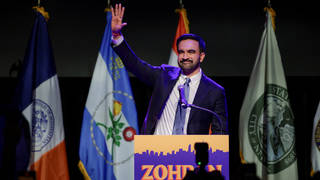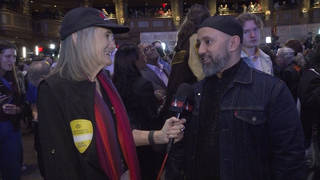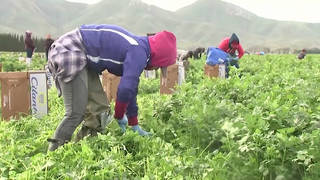
Guests
- P. Sainathaward-winning Indian journalist and founder of People’s Archive of Rural India, or PARI.
As COVID rages through India, which has the second-highest number of reported cases worldwide, hundreds of thousands of farmers are converging on the capital New Delhi to demand the government repeal new laws that deregulate agricultural markets, saying the reforms give major corporations power to set crop prices far below current rates and devastate the livelihoods of farmers. Agriculture is the leading source of income for more than half of India’s 1.3 billion people. The farmer revolt comes as some 250 million workers across the country took part in the largest strike in history against the Modi government’s neoliberal labor reforms. We speak with P. Sainath, a longtime Indian journalist and the founder of People’s Archive of Rural India, or PARI, who describes why working-class Indians are standing up against “absolutely vicious” new rules that were rammed through Parliament, and the protests show no signs of stopping.
Transcript
AMY GOODMAN: This is Democracy Now! I’m Amy Goodman, with Nermeen Shaikh, as we turn to India, where tens of thousands of farmers are converging on the capital city of New Delhi by tractor and on foot to demand the repeal of new laws that deregulate agricultural markets. The Indian Prime Minister Narendra Modi says the measures give farmers more freedom to set their own prices and sell directly to corporate buyers. But opponents say the neoliberal policies are a boon to corporations and roll back key labor and crop price protections that could have a devastating impact on the livelihood of farmers. Agriculture is the leading source of income for more than half of India’s 1.3 billion population.
The ongoing protests come after a nationwide demonstration Thursday, when an estimated 250 million workers, farmers and their allies joined in what’s believed to be the largest organized strike in history anywhere in the world. Organizers say tens of thousands of demonstrators have now gathered at each of New Delhi’s three borders, in cold winter conditions, and more farmers are on their way. Police have put up barriers to block them from coming into the center of the city. This is one of the farmers protesting.
FARMER PROTESTER: [translated] India is my country, and Delhi is the capital of my country. I am not even allowed to enter my capital city. This is in spite of farmers never doing any hooliganism. Our whole movement has been peaceful. They also showered us with water cannons. We were also beaten. But no farmers retaliated violently.
AMY GOODMAN: Today Indian government officials are meeting with farmer representatives for a fourth time, and farmer union leaders have invited Agriculture Minister Narendra Singh Tomar to their protest site.
This comes as COVID rages through India, which has reported more cases than any country in the world outside the United States.
For more, we go to Mumbai to speak with P. Sainath, longtime Indian journalist, founder of People’s Archive of Rural India, or PARI.
It’s great to have you back again. You used to write for The Hindu and used to write for The Times of India. You’re an award-winning journalist, but felt that the majority of people were not being heard, and you wanted to give voice to the voiceless. Talk about this most significant protest, the largest, it’s believed, the largest organized protest in world history, P. Sainath.
P. SAINATH: On the 26th of October, Amy, all the workers in the country, in many, many gigantic public sector units, in power, in transport, in a number of public sector organizations, and across the banks, the insurance companies, and workers from other set of departments ceased work and went out. And it’s interesting. They were protesting against a new set of labor codes, absolutely vicious codes, that have been rammed through Parliament. But the working class out on the streets endorsed the demands of the farmers at Delhi. So it was a tremendous show of unity and solidarity, when millions of workers were saying, “We are with the farmers.” So, that was one extraordinary thing. That was on the 26th of October.
The farmers now, I think that maybe there’s 200,000 to a quarter of million of them on five points on the Delhi border. The government approach to them is actually extremely callous and very, very aggressive. On the one hand, they’re putting out some stuff for the media saying, you know, they’re talking to them, they want to solve this problem. On the other, the prime minister is making speeches in his own constituency that this entire thing is a conspiracy by the opposition.
Now, if you need to know how deep this problem is biting in the farmers, as of yesterday, Punjab, which is a famous state for athletics in India, the Olympians, those athletes of Punjab who have won multiple medals at the Commonwealth, National Games and have participated in the Olympics, are planning to throw their medals back at the government on the 5th of December. Many artists and poets and others are returning their civilian awards. So, this is slated for the 5th.
And the government has no sign of shame about it at all. It is trying to look like the reasonable host. At the same time, it has put up barricades, barbed wire. It has dug 10-feet-by-10-feet trenches in the national highways to prevent these farmers from reaching Delhi, and have used water cannon and tear gas — water cannon in the coldest winter that Delhi has had. It had its coldest day in 70 years two days ago, and you’re using water cannons on people, several of whom, those farmers, are in their late sixties and early seventies. On that kind of person, you are using water cannons and telling the — and you have a captive media, of course, that makes it look like the government is just getting it wrong in the way they are talking to the farmers: “These are all hicks and brutal yokels. They just need to be spoken to sweetly,” whereas the laws that they are protesting, Amy, are devastating.
NERMEEN SHAIKH: Well, P. Sainath, could you talk about this protest, these protests, in the wider economic context in India? Unemployment is now at 27%, which is unprecedented in the country. As we mentioned earlier, almost 60% of India’s 1.3 billion people rely on agriculture as their main source of livelihood. In just two years, from 2018 to 2019, over 20,000 farmers died by suicide. Meanwhile, a billionaire, the richest man in India, Mukesh Ambani, has made $12 million an hour since the lockdown began as a result of the pandemic in March. Could you talk about the broader context of these protests?
P. SAINATH: Well, the entire protests, driven by a deepening agrarian crisis, are very fundamentally tied to the larger structural inequalities that you are pointing to. In just four months of the pandemic, just up to July, not only Mr. Ambani, but the entire bunch of Indian billionaires, dollar billionaires — there’s about 120 of them — added 35% to their wealth, one-third to their already considerable wealth, and it’s now around $485 billion cumulatively. Mr. Ambani went from being the richest Indian and the 19th richest person in the world; in the last year, year and a half, he has made it up to rank number four.
At the same time, Amy, there are new papers, studies showing us 76% of the rural population — that is, three-fourths of the rural population — cannot afford a nutritious meal. They cannot afford a basic nutritious diet, even if they spend — even if they spent two-thirds of their income on food. Now, apart from that, even if, say, all rural Indians spent 100% of their income on food and nothing else — no transport, health, education, rent; they didn’t spend anything of that — it would still mean 63.3% cannot afford a nutritious diet, if they spent every last paisa they earned, I mean, they got as income. So you’re seeing these unbelievable gaps, phenomenal gaps. India ranks fourth or fifth in the list of dollar billionaires in the world, and 129th on the U.N. Human Development Index.
And the pandemic has provided — you need to understand one very important thing about the protests. And for that, you need to understand what kind of mischief was played in the laws. Three major laws have been passed in Parliament which devastate the farmers, and you mentioned them as you introduced the subject. Two days later, when the opposition walked out in protest, they rammed through four labor laws codifying 29 existing complex legislations, and made them into four and rammed it through.
Now, the question is: Why did they feel the need to pass these laws at the height of the pandemic? Mr. Modi had a majority before the pandemic. He has a big majority. He will have it for two, three years after the pandemic. The reasoning was, these blokes are on their knees now. They can’t organize. They can’t hit back. And in fact, many leading neoliberal intellectuals, economists and journalists, editors, incited the government, saying, “Never waste a good crisis,” paraphrasing Winston Churchill, by the way, badly. “Never waste a good crisis. This is India’s second 1991 moment” — when we embraced the world of neoliberalism. “This is the time to ram through aggressive, next-generation reforms.” And the government, believing that, went for this action, not understanding the resolve of these farmers, who have come back massively at the government.
Just one clause I want to read you from the laws. You will not believe — I don’t know. You can tell me if you’ve ever read laws in a democratic nation which have a clause like this. Not only have they rammed through these laws, you know, on prices, on contract farming, on essential commodities, they have included this clause in one of the most important of these laws. It says, “No suit, no prosecution or other legal proceedings shall lie against the central government or the state government or any officer of the central government or any officer of the state government or any other person in respect of anything” — [read corporations] — I mean, “read corporations” in brackets — “or any other person in respect of anything which is done in good faith or intended to be done in good faith under this act. And no civil court shall have jurisdictions to entertain any suit or proceedings in respect of any matter connected to the actions under this law.” Have you read many laws like that in a democratic country?
So, they have taken with the legal recourse of the citizen. And I’ve been yelling of this that it’s not just the farmers who are affected. Nobody else can sue, either. They are dismantling the right to legal recourse. The Bar Council of Delhi, you know, the capital city — the Bar Council of Delhi yesterday wrote to the president of India, saying, “This is an extremely dangerous thing that’s happening. You’re taking away the fundamental rights of the citizen to move the courts when in distress.” So, this is the kind of stuff.
And at the same time, the inequalities are deepening. The unemployment figures, that, Amy, I mean, they have come down as some amount of opening up happens, but people are returning to much worse conditions as workers. We have tampered with the gold standard of labor law, which used to be eight hours a day. Now you can have 12 hours a day without overtime for the last four hours. It’ll be at a pro-rate, I think. You are having a massive, massive class divide in what’s happening, with the top 0.01% adding phenomenally to its wealth and a huge amount of distress at the bottom end.
AMY GOODMAN: I want to go to a clip of Birendra Singh, as we talk about COVID and the effect of the pandemic on India. He used to run a food stall in Andhra Pradesh. He explained to your news organization, to PARI, the People’s Archive of Rural India, how his family has been affected by the lockdown.
BIRENDRA SINGH: [translated] Before the lockdown, our days would go like this: We would wake up at 4:00 in the morning and start to make puris. Four hours would go in just making these puris. From 3:00 in the afternoon to 10:00 at night, we used to do business. By 11:00 in the night, I would reach home. Then, from the next day, this same work, Sirji. Before, work was going well. We were eating properly. I could take care of my parents, too. Since the lockdown began, I have been in deep trouble.
NERMEEN SHAIKH: So, P. Sainath, could you talk about what the situation with lockdown in India is, and the fact that the mortality rate there from the coronavirus is apparently reportedly much lower than the mortality rate certainly than here in the U.S., but also Europe?
P. SAINATH: It may be. It may be lower than that of the U.S., but the numbers we have on COVID-19, on infections, on the fatality rates, are extremely suspect, barring one or two states which are very good at following up, tracking, tracing, like a state like Kerala, which has done much better. And a hell of a lot of the testing — I mean, we are doing very low levels of testing. And you will get lower numbers. Second, much of the testing, the bulk of the testing in many states, is done on rapid antigen basis, not on the RT-PCR. And the rapid antigen has — as you know, the RAT tests have a very high proportion of false negatives. So we don’t really know. And I don’t buy this idea of being one of the lowest fatality rates in the world. It’s true of one or two states which have a much better health infrastructure and a much better system of public health than a country, as a whole, which spends 1.28% of its gross domestic product on health and, two, most of the expenditure on health is out of pocket by poor, ordinary Indians. In fact, the last three surveys on health in the National Sample Survey have shown the number of Indians not seeking medical attention purely for financial reasons has doubled in 20 years. So, I’m not going to buy into this.
The second part of your question — I mean, the second aspect of your question, Nermeen, is that there are an incredible number of non-COVID deaths which have happened because of the complete collapse of the health infrastructure and the total focus of what little there is on COVID, so people dying of cardiac arrest, people dying of diabetic and stroke, and people dying of a number of other diseases, curable, treatable diseases. That number is surging massively. I, myself, since April 5, have lost 14 friends and acquaintances whom I knew very well. Just one of them — just one of them died of COVID. OK? Many of the others, their families took them from hospital to hospital to hospital to try and get admission, and couldn’t. And also —
AMY GOODMAN: P. Sainath, we’re going to have to leave it there, but I want to thank you so much for being with us. And, of course, we’ll be visiting with you again in Mumbai, India. P. Sainath is the award-winning Indian journalist, founder of People’s Archive of Rural India, or PARI.
Very happy birthday to Emily Gosselin! Tomorrow, Paul Farmer. I’m Amy Goodman, with Nermeen Shaikh.












Media Options